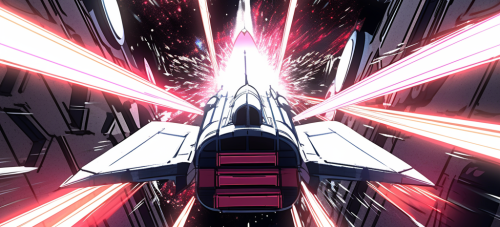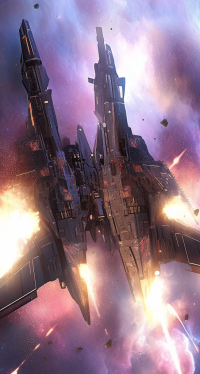Table of Contents
Setting Travel Guide
See the stars they said! It'll be fun they said! Just a quick trip to the nearest Gate, they said! Now we're stuck here getting raided by pirates!
The Setting Travel Guide is a basic outlying guide on how space-travel works in the Calliope Star Cluster. This guide affects all craft in setting1).
Faster than Light
Faster than Light (FTL) travel in Project Multiverse comes in many flavors, but all of them are beholden to the rules set by the sector itself. Only the mightiest powers of the sector have ways around these rules - which they might share, for a fee.
Basic FTL travel takes, at minimum, two weeks to cross each square on the sector map2). Any attempts to exceed this limit subjects the vessel and its passengers to spatial chaos, potentially leading the ship astray or worse.
There is one exception that allows vessels to ignore spatial chaos entirely. The Gate network, built by the Precursors and managed by the Gatekeepers, allow anyone to travel from one Gate to another connected Gate instantly. The Gatekeepers charge a fee in their own currency, Gate Credits3).
Shards can implement whatever form of FTL travel they like, so long as they follow setting rules.
Traveling Beyond the Speed of Light
Engaging Hyperdrives
Gravity wells and anomalies prevent ships from crossing their affected areas; to do otherwise is to destroy or severely damage your vessel. Solar systems extend their gravity wells a few light minutes beyond the orbit of their most distant planetary body4). These areas cannot be created artificially.
Faster than light travel is always performed in a straight line. Ships may need to make multiple stops as they avoid dangers, changing course each time.
Regardless of the form that a Shard's FTL travel takes, it requires a minimum of five minutes of time to prepare before it can be used. During this time, anyone nearby who has a grasp of FTL travel can determine the direction of the first “hop” and potentially match course.
Unfriendly Neighbors
If vessels are travelling in the same direction at FTL speeds, they are visible to one another and can even be interacted with. This includes firing projectiles or other weaponry.
If a vessel is damaged to the point that its FTL systems, whatever they may be, are no longer functional, then it immediately drops out of FTL speeds and back into normal space.
Gate Travel
The Gates are a series of Gate Terminals and Gate Hubs that facilitate near-instantaneous travel from one Gate to the next. To use a Gate, you must first travel to it. Once you've arrived, you pay the Gatekeepers their fee5) and then you can jump to another Gate's square or a square immediately adjacent to it.
Access to the Gates is fiercely protected; any force attempting to monopolize one or more Gates through military action or other interference rarely survives for long. The Gatekeepers are very happy to issue bounties for anyone involved in the practice. Even pirates and raiders give the Gates several light minutes of safe territory before engaging in their activities.
Spatial Chaos
We're where?!
Whether out of desperation or a need to prove themselves, sometimes vessels will try to exceed the maximum amount of safe FTL speed. When this happens, they face Spatial Chaos - a phenomenon that affects space and time. For each day they attempt to shave off of their journey, the effects become worse and worse.
To determine the results, use the /roll command on the Discord server's #plot channel. You will do this 3 times, adding the numbers of days that you reduced the FTL limit each time. For example, if you shaved a week (7 days) off of the two week travel time, you would roll the following three times:
/roll 1d6+7
Then go through this list in order, using the result of each roll in sequence:
- Deviation: You arrive (result-2) light years away from your destination.
- Dilation: The vessel's contents, including its passengers, experience (result-2) years pass.
- Distortion: Shields, engines, and other non-critical systems6) take (result-2) hours to come back online.
Unlucky 7's
After the Spatial Chaos roll, if the result7) is all 7's the ship is destroyed during transit. The passengers may survive, but it's on the players to decide what to do next.
Slower than Light
As with FTL travel, Shards are welcome to utilize whatever forms of STL travel they like, so long as they don't interfere with the setting's rules.
Assuming a system around the size of Sol8), it would take around a week at the fastest STL speed to go from one edge of its gravity well to the other. This means roughly half a week from the center of the system to its outermost edge.
Class Matters
Ships take longer to accelerate and navigate as they increase in size. Swift fighters will always outrun massive capital ships during STL travel, no matter how many engines the larger ships might have. We want to avoid keeping track of actual speeds, so the rule is the larger something is, the slower it travels and the less maneuverable it is.
There are no exceptions to this9).
Navigating
Vessels must avoid asteroids, planets, large space debris, and so on, during their travels.
Any potent protection technologies, such as shields, slow a ship down by an amount proportional to their protective capabilities.
Phasing, teleporting, and other elements that allow vessels to ignore matter don't work outside of their Shards. Should two Shards come into conflict, these effects do not work for the duration of any combats that they are in.10)
Nebula Travel and Rolling
The Calliope Star Cluster is home to an outstanding amount of Nebula and astral bodies. These are not simply for show, and carry their own rules for passing through them. As such starships of technological or magical inclinations both suffer from debilitations to their travels when passing through nebula of any kind.
- Passing through or into Nebula obscure a ships signature or help hide it altogether.
- Nebula effect shields, power sources, communications, and certain types of weapons of tech or magical inclinations for purposes of RP.
- Passing through a nebula should be viewed and treated/written the same way as a vehicle passing through an exceptional storm; High winds, low visibility, danger, potential damage, increased chance of damage or obstacles, etc.
- Ships in a nebula are not easily discovered from outside unless in large fleets. Or until just about to exit a nebula.
- Large cosmic megafauna, ghost vessels11), and many types of dangers not found outside of nebula exist in these places.
Hadals Chasm
The massive nebula splitting the Calliope Star cluster is unique compared to most other nebula. Not only is it substantially large and more turbulent than other nebula12) but poses a high risk to any vessels attempting to cross through or into it.
As such not only is the Chasm not possible to be colonized by even the hardiest of outposts of any nation but contains forces, dangers, and treasures galore found nowhere else in the sector. So turbulent is this place that not even the Gates can penetrate ships into it.
(The chasm is designed to be explored and RP'd in by players and nations alike but cannot contain outposts, settlements, core or non-core systems, or pretty much anything that would allow anyone to place even the simplest claim on any portion of it. It contains mysteries such as the precursors systems and their fate, and is designed to house major sector-spanning threats for future RP.)
Dice rolling for Nebula encounters
Using the discord or through a software, Roll 1d100 for every grid square in a nebula your ship(s) pass through on the map and apply the rolled effect (use the roll function on the discord for convenience and ease of access!). Note that this is intended as an RP tool for GMs and not as a system to be abused in PVP scenarios. (But if you just happen to be fighting in a nebula dont forget to roll anyway, it will make the fight more interesting!)
Roll 1d100 and apply the following effect to your ship(s):
- 01–10. Cosmic forces and anomalies favour you! Your ships pass through this grid square safely and ahead of schedule!
- 11-15. Your ships pass through this grid square safely at a normal pace.
- 16-18. Your ships pass through this grid square but take twice as long as
- anticipated (If unsure round up to a week for standard-sized vessels)
- 19-21. Roll 1d6. Cosmic forces cause the number of characters chosen by the GM to suffer amnesia until passing into the next grid square.
- 22-24. Your ship encounters a derelict and damaged ship that may or may not contain survivors, treasure, loot, technology, unknown threat, intel, etc. (GM discretion)
- 25-27. Your ship suffers one random failure until passing into the next grid square, roll 1d6 (1-engines, 2-life support, 3-weapons, 4-shields, 5-communications, 6-navigation)
- 28-30. Your ship passes into the next grid square safely, except no time has passed (the GC date IC remains the same as when you rolled to when you enter your next grid square)
- 31-33. You detect a neutral star-faring vessel of the GMs choice of faction at the edge of your sensors.
- 34-36. You encounter 1d3 times the number of ships accompanying you at the edge of your sensors. Roll a second 1d3 to determine intent (1-neutral, 2-friendly, 3-hostile)
- 37-39. Pirates! 1d3 times the number of ships accompanying you hail your vessel(s) and declare their intent to board you and make off with anything from cargo to crew or the ship(s) themselves!
- 40-42. Boarders! A stealth vessel has deployed boarding torpedoes and has unloaded 2d12 boarders into your vessel for GM discretion purposes.
- 43-45. A number of players/npc chosen by the GM revert in age back to their teenage or pre-teen years until entering the next grid square. The GM chooses if they keep their adult-age memories or only recall the memories of the age they are changed to (18+ Rule applies to characters or NPCs changed to children.)
- 46-48. Cosmic storms batter your ship! Until you enter your next grid square your vessel takes minor damage, Roll 1d100 and take another encounter on the list!
- 49-51. Your ship encounters a random derelict space installation that may or may not contain survivors, treasure, loot, technology, unknown threat, intel, etc. (GM discretion)(edited)
- 52-54. Your ship passes through a particularly rough patch of cosmic storms. Roll 1d6, that number of characters chosen by the GM (PC or NPC) swap minds/bodies with each other until entering the next grid square.
- 55-57. Your ship encounters… Itself? Encounter a mirror twin of your own ship in every way, even down to the crew. If personally meeting, the two crews become increasingly paranoid and unsettled towards each other as time goes on.
- 58-60. 1d6 random hallucinations/apparitions appear on your ship. They haunt your crew and become increasingly violent and traumatic towards the crew until entering your next grid square.
- 61-63. One random (GM chosen) player character or NPC are possessed by an obsession with the GMs choice.
- 64-66. One random (Gm chosen) player character or NPC are literally possessed! A malevolent spirit with intentions chosen by the GM and told only to the player (or controller of the NPC) in secret and not to the other players is possessed until passing into the next grid square.
- 67-68. Massive space-fairing megafauna has taken an interest in your ship! Either curiosity, territorial instinct, or just plain boredom a massive creature much larger than your ship is approaching you!
- 69. Strange radiation that can even pass through your shields has risen the ambient temperature in the ship to just hot enough to fluster the crew. The heat does more than just making clothes uncomfortable, and everyone's opinion of each other (even rivals or those with a dislike of each other) is risen to a concerning degree until entering the next grid square (Skip if plot is not 18+!!!!!!!!)
- 70-72. The gravity in the ship fluctuates frequently, causing gravity to shift in random directions.
- 73-75. A random player character chosen by the GM suffers an injury serious enough to put them in the medbay until passing into the next grid square.
- 76-78. A corpse in the ships medbay/morgue suddenly wakes in perfect health (PC or NPC)
- 79-81. The ships brig suddenly unlocks or something intended to be contained is let loose. If no brig or contained creature/item is present re-roll.
- 82-84. Roll two random encounters. Both happen simultaneously.
- 85-87. Your ship passes completely through the nebula and out the other side in a straight line in the direction they are travelling even across multiple grid squares.
- 88-91. Your ship passes completely through the nebula and out the other side in a straight line in the direction they are travelling even across multiple grid squares except one year has passed for the crew inside the nebula since the time of rolling!
- 92-94. Your ship suffers a random and critical failure and is left adrift.
- 95-97. An unknown fleet much larger than yours (Identity at the GMs discretion) is detected close to yours and has your ship(s) caught in tractor beams and is pulling you closer.
- 98-99. Your crew, PCs, and NPCs suddenly dont recognize one PC chosen by the GM as part of their crew and are suspicious to their identity and distrustful if not hostile towards them.
- 100. Roll 1d3 times number of ships if in a fleet. That number of ships are lost in the nebula and never found again. If ship is alone re-roll.
OOC
Usage
This article's content adheres to Project Multiverse's submission and usage rules.


